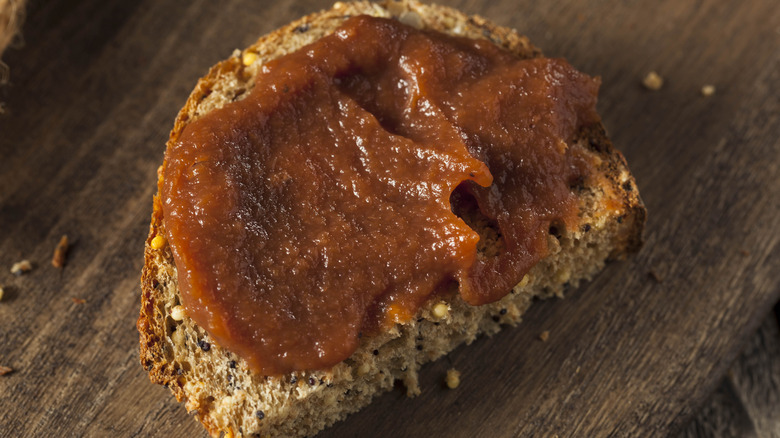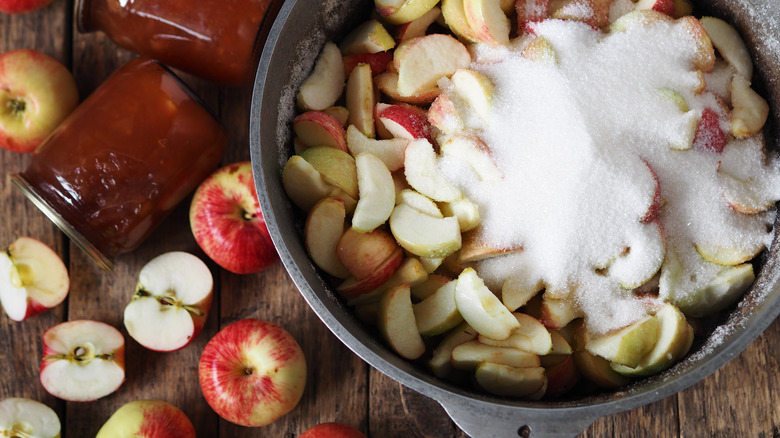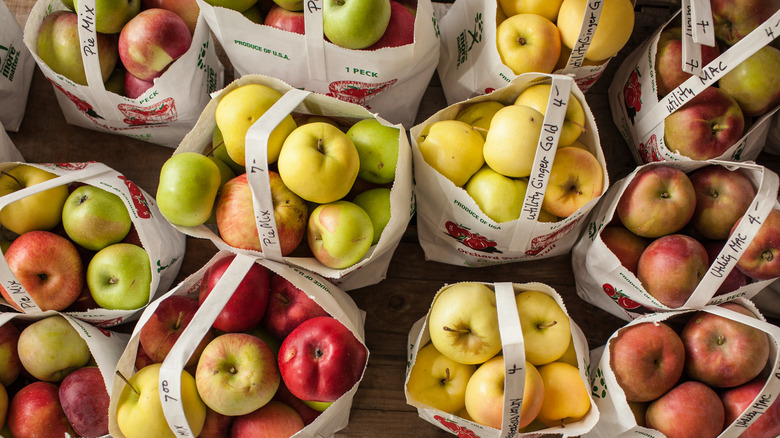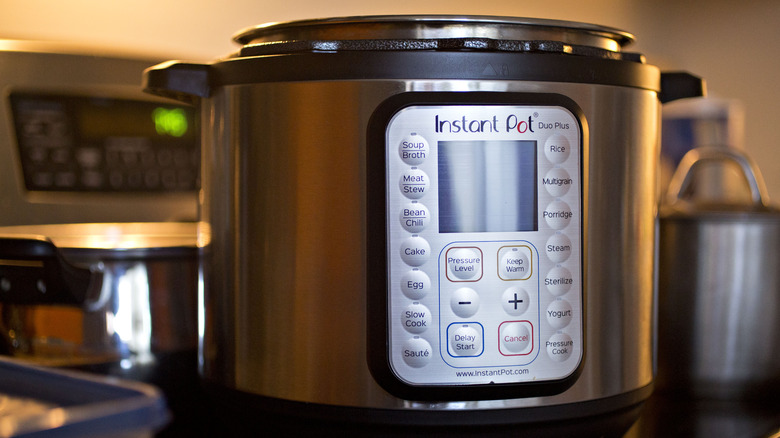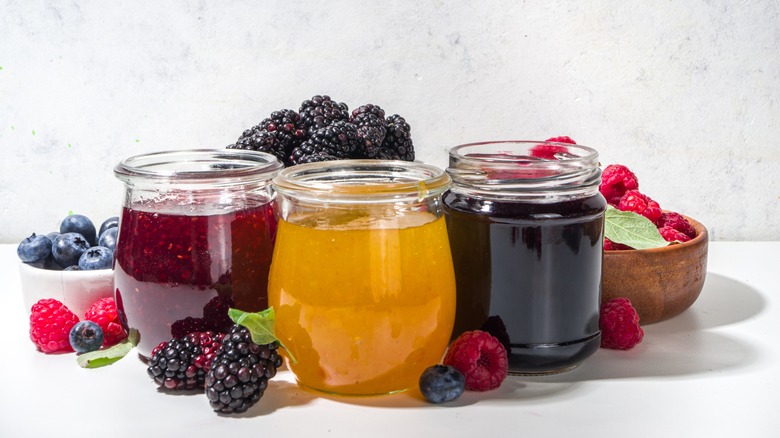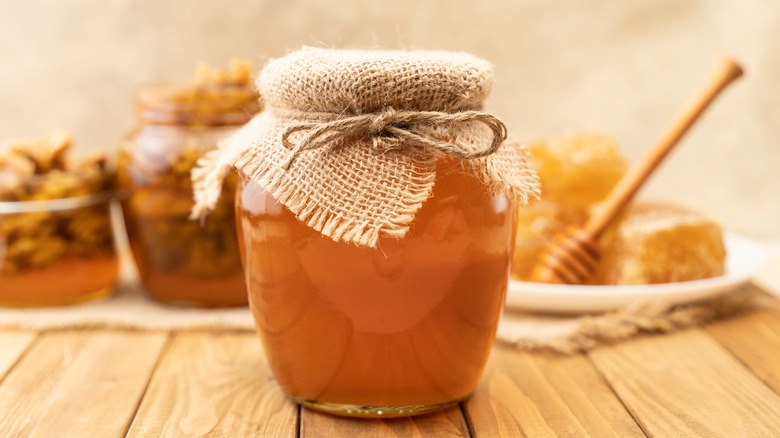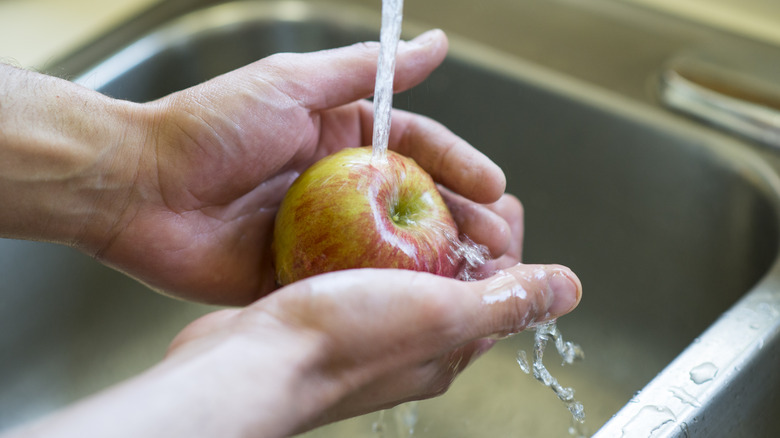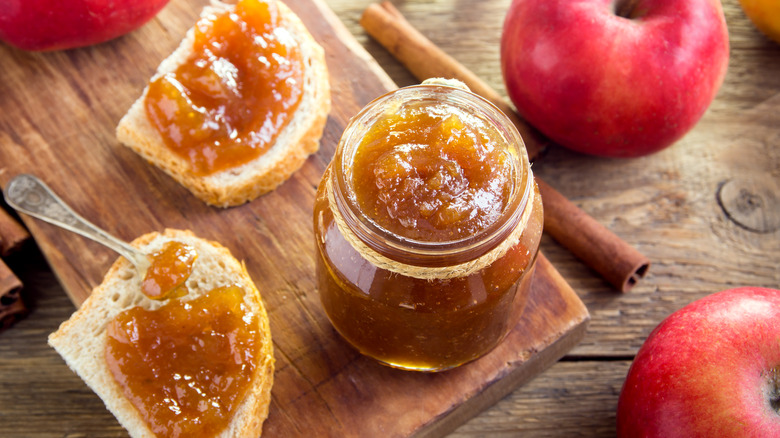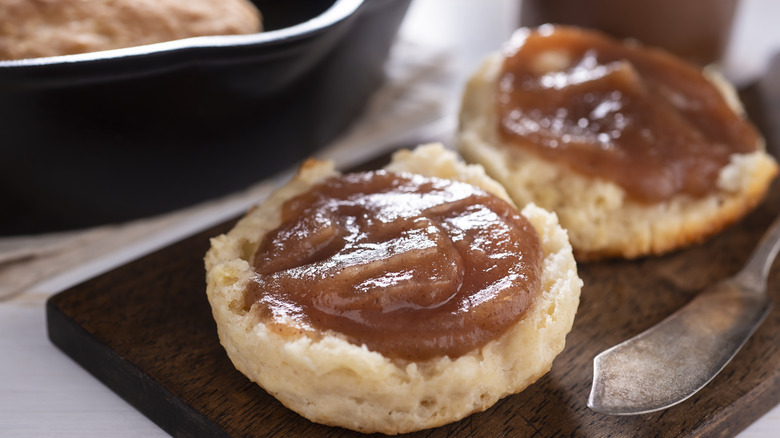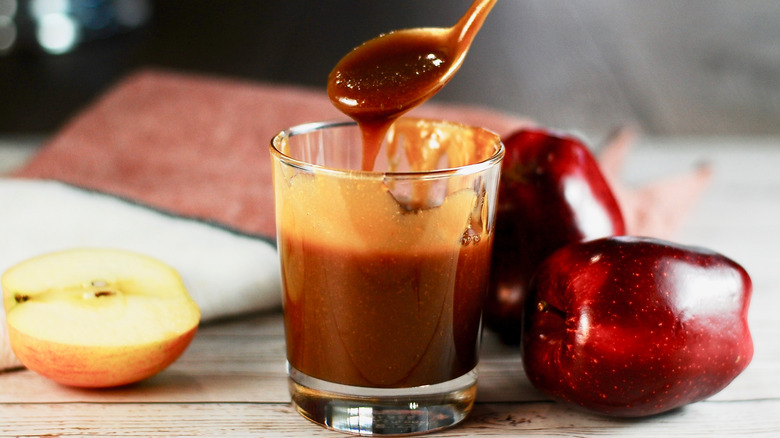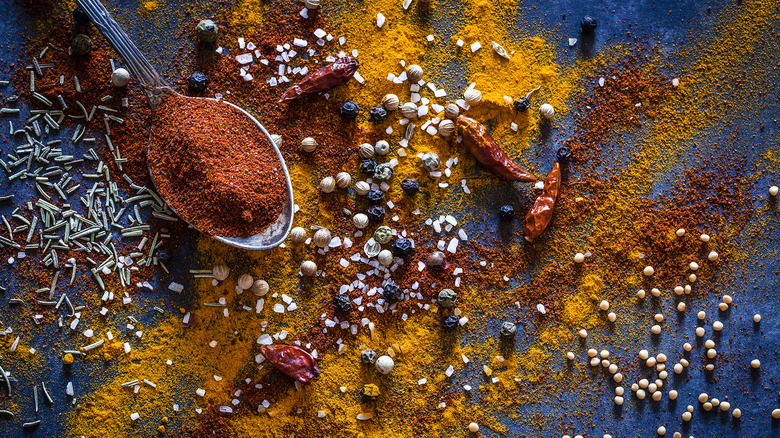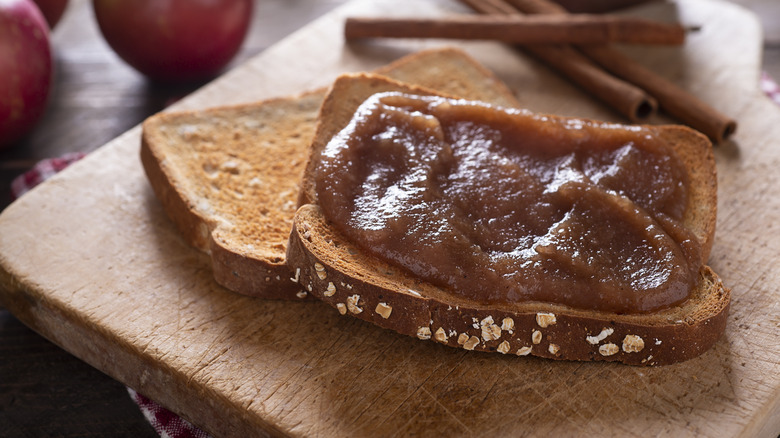12 Tips For Making Mouthwatering Apple Butter
Apples are the classic representatives of the fall season. This is when they peak and appear in their ripest, juiciest shape. Though they are already perfect in their fresh, natural form, they have almost magical transformation possibilities. They bake and fry well and easily turn into aromatic sauces and ciders. However, apple butter — the wonderful mix of stewed and pureed apples with sugar and spices — is often unfairly underestimated in the whole apple talk. Thicker than apple sauce but slightly different than other fruit jams, apple butter deserves more credit and should be given more room to show all its attributes.
Despite the common misconception, there is no butter or dairy in apple butter. The name is likely a reference to its spreadable, butter-like texture or perhaps how well it agrees with buttered toast, but that's where all similarities stop. Apple butter is a fruity spread made with tender, cooked apples, sugar, and spices, often with a cup of cider. The mix is cooked, pureed, and stored in jars, ready to be used as a preserve. Apart from the obvious use on top of bread, there are many other savory and sweet dishes that would blossom with a spoonful of apple butter.
Apple butter is the best way to repurpose apples, and though the process sounds seemingly simple, these several easy-to-follow tips will turn your bland apple butter into a lip-smacking, flavor-packed spread, possibly earning the label of your new favorite pantry staple.
1. Do not try to speed up the process
There are no shortcuts when making apple butter. Though there are alternative ways to make it and various modern cooking gadgets you can use, there is no right way to speed up the process. To attain that distinctive, smooth texture and complex flavor, you have to give it time and leave your apples to cook down on low heat.
Essentially, apple butter all starts with apples. These naturally sweet products need to be cooked into a soft, tender mash. They are combined with sugar, and as they are heated, the added sugar and the sugar from the apples will start to break down and caramelize. The caramelization process will lend apple butter its deep, brown hue, but it will also significantly impact taste by creating a medley of toasty, caramel-like flavors. The longer you allow the caramelization process to go on, the more flavor you will get. It will become deeper, more pronounced, and more complex.
Caramelization can happen quickly with particular techniques — for example, grilling honey-marinated steaks — but when it comes to apple butter, low heat is essential as you first want to give apples time to break down. High heat and short cooking time are not good for apple butter and can only lead to a burnt, bitter mess.
2. Not all apples are created equal
Apples are the quintessential ingredient in apple butter and the only invariable element. However, there are so many varieties around that you can always play with the selection. Different apples create different textures and can help you toy with flavor profiles. Naturally, as apple butter requires long cooking, sweetness, and some brightness, some apples will perform better than others.
Ideally, you want to use soft-fleshed varieties that will cook down faster. They should have sweetness and zest, but none of the elements should stand out or dominate. Finally, you want to use the most aromatic varieties whose character will not dissipate in the long cooking process. Among the incredibly vast group, Stayman apples are an excellent choice. It is a widely available variety with enough sweetness and acidity to make a lovely apple butter blend. You can never go wrong with classics such as Golden Delicious, Pink Lady (Cripps Pink), and Braeburn. These are commercially available varieties that will deliver consistent results.
Of course, not all apples are suitable for producing apple butter. You want to steer clear of apple varieties with dry, floury flesh that will make the texture fibrous and almost dusty on the palate. You also want to avoid sturdy types such as Jonathan apples as they are simply too firm, and the crisp, zesty cultivars such as Granny Smith would not perform well due to the piercing, bright acidity.
3. Use slow cooker or Instant Pot for a hassle-free experience
If spending hours hunched over a stove and mixing vast amounts of apple butter is not your idea of a fun cooking activity, grab your reliable slow cooker or Instant Pot and leave them to do all the heavy work.
Using a slow cooker to make apple butter seems like an obvious choice. As ap†le butter calls for long and slow stewing, it perfectly fits the slow cooker approach. The technique could not be more simple. Add all the ingredients at once, cover the pot, and leave it to cook down. You can set it on high or low — this usually takes from six to 12 hours — and then simply forget about it. Once the mix is thoroughly cooked, all you have to do is blend it and store it inside jars. The slow cooker approach does not call for extra liquid, but you can add some for flavor.
Another hassle-free idea is to use the versatile Instant Pot or any pressure cooker. The method is relatively similar, albeit much faster. The ingredients are cooked under pressure for around 30 minutes and then finished with the slow cook or sauté option. The results are usually consistently good, and the Instant Pot will create smooth, perfectly caramelized apple butter in no time and with minimal effort.
4. Leave the oven to do all the work
If your kitchen is not equipped with a slow cooker or Instant Pot, the oven is the trick you have been waiting for. Though it is the less conventional method, the apple butter finished in the oven is just as good as the traditional stove-top version, but it can also match those other swift, hassle-free varieties.
The oven is used at the final stage. You will first have to cook the apples with liquid and spices until they soften. Run them through a food mill or a blender, and then pour the mix inside a wide, deep pan or cast iron pot. Leave it in the oven at a low temperature for a couple of hours with an occasional stir. When you pull it out, your fruit and sugar blend will attain those caramelly, toasty qualities, and you will have thick, smooth, and flavor-packed apple butter ready to be stored and enjoyed throughout winter. Though it will not cut out all the steps in the process, the oven will save you from all that tiresome stirring while waiting for the apple butter mix to thicken and caramelize.
5. Don't treat apple butter as a traditional fruit preserve
Apple butter is a typical, autumnal preserve that can be stored for months. Though it is often compared to jam and jellies, at its core, it is a slightly different product.
The traditional jam-making method includes cooking chunks of fruit with sugar. Most fruit will easily break down into smaller pieces or thoroughly dissipate, but you always want some of that chew and texture to remain. Apples would not be able to go through the same process as they take much longer to cook, so it is best to cook them first, then mill them to attain uniform, smooth consistency, and finally cook the mix until it achieves the desired texture. The processes are rather different and apples need this slight adjustment if you want to make real apple butter.
Regardless of the preparation method, you can enjoy apple butter as a traditional jam. Serve it on top of (preferably buttered-up) bread, pair it with muffins, or add it to your morning oatmeal bowl. Apple butter also has the advantage over most chunky jams due to its silky consistency, so use it whenever you need smooth and easily spreadable fruity preserves.
6. Increase complexity with brown sugar, honey, or maple syrup
White sugar is the most common sweetener in apple butter. Though cheap and easily accessible, it mostly comes off as one-dimensional. It will successfully perform its job and add sweetness, but many other options will do the same while also adding more flavor.
Brown sugar is perhaps the easiest swap, as you probably have some in your pantry. As it is slightly more complex than white sugar, it will add much more character to apple butter. Try the less refined versions, such as muscovado, for more robust expressions. If you want deeper, more pronounced flavors that will deliver plenty of aromatic and caramelly notes, opt for honey or maple syrup, which have a greater spectrum of flavors and a much more diverse profile that cannot be recreated with any heavily processed ingredient. Make sure always to use natural honey and maple syrup and not cheap imitations that are made with low-quality corn syrup.
If you want to make a healthier alternative and avoid all classic sugars, a good tip is to use dates to add sweetness. Dates are packed with natural sugars, which will add more flavor to your apple butter. You can simply replace some of the sugar with fresh dates. Medjool dates would work nicely here due to their soft, juicy flesh and mellow flavor.
7. Clean your apples thoroughly but leave the core and skin for more flavor and better texture
There are many recipes for apple butter, but you can roughly divide them into the ones that peel and core the apples and those that slice whole fruits into larger chunks. Apple peel is usually full of flavor, so always try to leave it on if possible. If you are using a food mill, this should not be a problem as the peel will be removed in the process. You won't have any pieces inside the butter, and it will attain maximum flavor. Of course, if you leave the skin on, wash it thoroughly, and it would be best to go with organic apples. You can probably find them at farmer's markets or specialized stores. Reaching out directly to farmers can also work.
Popular lore made apple seeds infamous for containing cyanide, a poisonous chemical compound. In reality, things are a bit more complicated, and the seeds don't actually contain cyanide but a different compound that can produce cyanide when in contact with digestive enzymes. However, to produce an amount of cyanide that could cause harm, you'd have to eat around 25 apples at once, which is unrealistic. Even if this does not convince you to eat whole apples, you should always leave the core when making apple butter. The core is packed with pectin, a compound that acts as a natural thickening agent and will make your butter firm and dense.
8. Blending is the secret to the creamiest apple butter
Most traditional apple butter recipes suggest the use of a food mill. This metal device was commonly used to mill and mash various fruits and veggies that were later made into preserves. However, the mill has become a slightly outdated tool in contemporary kitchens, probably due to its bulky size and the fact that it has to be operated manually. If you do not own one, you can easily replace it with modern, high-speed blenders that are essentially faster and more efficient tools for making apple butter.
Just like with the food mill, you want to use the blender as the second step after the apples have been cooked until tender. The fastest way is to use a classic countertop blender that swiftly turns apples into a silky-smooth blend. If you are working with large batches, do it in portions. Alternatively, the hand immersion blender will let you mix the apples inside the pot you used to cook apples. The latter technique will require more elbow grease, but it will also save time on washing up. Regardless of which blender you choose, the result is always a perfectly uniform, smooth apple butter base.
9. Always check for doneness
One of the trickiest parts when making apple butter is telling when the butter is ready and should be taken off the stove. Many will rely on the time stipulated in the recipe or simply eyeball the situation and assess when it's done based on thickness and consistency, but both methods are quite unreliable.
The trick here is to use the classic doneness test, the same that is used for jams and jellies. The easiest way is to spoon out the butter and if it easily slides off the spoon, it should be cooked longer. The classic and the most reliable method is placing the spoonful inside a bowl or on a ceramic, preferably a well-chilled plate. If the heap of butter stays put and has no runny liquid swirling around it, it's all set and ready to go.
Even if you are working with a trusted recipe, do not skip the doneness step. The quality and the properties of the same apple variety can vary depending on the season, so you should never follow the recipe blindly. It's best to regularly check for doneness throughout the cooking process until you get to a firm, stable texture.
10. Give apple butter more character with other ingredients
Apple butter is great as is, but you can always treat it like a blank canvas and play with creative spins on traditional recipes. Although it is quite fragrant, apple butter is not too potent or obtrusive in flavor and can pair nicely with many ingredients.
If you want to diversify the apple butter game, the most logical choice would be to go with other fruits. Pears, traditional seasonal partners to apples, would be a great choice as they have similar textures. The flavors are known to work together well. If you want to completely step away from tradition, turn your apple butter into a boozy spread. Whiskey, preferably a well-crafted bourbon, would be a fantastic addition to apple butter. Bourbon's warmth and sharpness would go well with the buttery character of the preserve.
Another idea is to boost the caramel flavors by adding caramel sauce. Apples and caramel are perfect companions, and you can simply mix in the sauce before canning. Both homemade and store-bought sauces would work here.
11. Don't be afraid to get creative with spices
The spices in apple butter are not usually subtle or subdued. They make a large part of the flavor profile, but most recipes stay true to the classics. Cinnamon always makes the list, usually accompanied by cloves and nutmeg. And though no one can argue against these choices as they are virtually natural partners to apples and always work well, sometimes it can be nice to diversify flavors and make apple butter a little bit more exciting. With such a wide array of available spices, it would be a shame to always opt for the traditional route.
Naturally, the best options in the apple butter context would be warming and fragrant spices with a touch of spicy sweetness. Allspice is the first on the list that could easily work well in apple butter. Although similar to the classic spice trio of cinnamon, nutmeg, and cloves, it has more earthiness and a lightly spicier character that could add a more serious note. Cardamom, which has a piercing, zesty note, could add brightness, and a touch of ginger is always appreciated to refresh the palate, especially if you are working with a sweeter apple variety that calls for extra zing.
12. Give more purpose to apple butter in the kitchen
The last but no less important tip regarding apple butter is to use up its full potential. This fragrant, buttery preserve can rev up many sweet or savory dishes. In traditional terms, we are accustomed to seeing apple butter used on top of bread, scones, or cookies. If you take it out of the classic spread range, you will realize that apple butter can be a fantastic topping, an excellent condiment, and a mouth-watering sauce.
Use apple butter the way you'd use any fruit preserve: Dollop it onto yogurt, ice cream, pancakes, or waffles, stir it into your oatmeal, or use it to give your baked goods a burst of fruitiness. This preserve would also be a superb addition to a cheese plate, as it would pair nicely with most aged and fresh cheese varieties.
Along with sweets and desserts, the multipurpose character of apple butter shines through in savory recipes. Brush it onto meats — such as pork, chicken, or turkey — or use it in marinades. You can even stuff it inside burgers, and make sure to try it with pork, the protein that goes well with apples in any shape or form. Lastly, add it to drinks, including festive Halloween punch. The butter will melt quickly, but it will impart tons of flavor.
